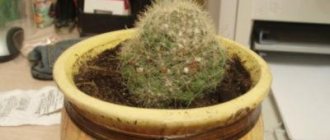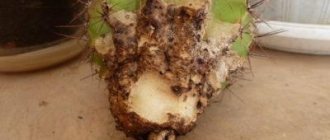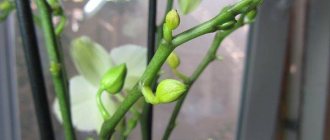What time of year is best to propagate?
Planting a cactus shoot can be done throughout the year , but still the best time is spring and summer.
The fact is that the birthplace of succulents are countries with hot climates. The temperature regime and daylight hours during spring and summer are close to the “native” weather conditions of this flower. In addition, any plant in warm weather experiences a phase of active vegetative development, which will greatly facilitate the process of rooting the succulent. In late autumn and winter, you can also try to plant a baby adult cactus, but you must remember that the young plant will need additional care: providing enough light, observing the temperature regime.
Selection and preparation of land for planting
Priming
Ordinary garden soil is not suitable for rooting and growing cactus. A special substrate for succulents can be purchased at a flower shop, the main components of which will be river sand, humus from leaves and turf, peat and all the necessary nutrients.
If it is not possible to purchase this mixture, you can prepare it yourself:
- coarse river sand, garden soil, peat mixed in a ratio of 1:1:0.5;
- you can add some crushed dry leaves and foam balls.
Drainage
A necessary component of the internal filling of the pot, in which a cactus without roots will be planted, is drainage - a layer of certain materials that helps drain excess water when watering. The drainage volume should occupy a maximum of 1/5 and a minimum of ½ of the container. Drainage may consist of :
- expanded clay;
- pebbles;
- small pebbles;
- broken bricks;
- broken foam;
- pre-cut wine corks.
Seed method
The method is necessary to update the collection and rejuvenate existing specimens. Over time, the breed degenerates; plants obtained vegetatively are less decorative and become sensitive to the effects of adverse factors. In this case, you need to plant the cactus with seeds.
Preliminary preparation consists of treating the planting material with a weak solution of potassium permanganate. It is permissible to soak the seeds in it for 8-10 hours. The container is used as a general container, filled with drainage, then 5 cm of a special substrate for cacti. Water the soil with water at a temperature of +40-45 °C, wait until the excess flows into the pan, and drain.
Use a toothpick or match to prepare small holes at a distance of 1.5-2 cm from each other. Using tweezers, place the processed and dried seeds into the holes. There is no need to fill it with sand or substrate. Cover the container with a bag or glass and place it on a well-lit windowsill, protecting it from direct sunlight. Maintain the temperature within +22-25 °C. The first shoots should appear in about a week, some varieties can germinate within 1-2 months. Gradually remove the cover after the first spines form.
Selecting and preparing a pot
Material
Many gardeners advise planting succulents in plastic containers , since plastic is a substance that does not absorb water and does not change the temperature of the soil placed in the pot.
Lovers of everything environmentally friendly can easily plant a succulent in a container made of clay or ceramics.
It is better if the pot is light in color so that the soil in it heats up less.
Size
Cacti grow in arid climates, so they have a long root system . Therefore, when choosing dishes, it is necessary to take into account the fact that its root system needs space, which means that cramped and small dishes will not be suitable for planting. Preference should be given to wide and deep dishes, in which the roots of the plant will feel free and will receive a sufficient amount of moisture and nutrients.
The main condition that a cactus pot must meet is the presence of drainage holes to drain excess water. Otherwise, the liquid accumulating at the bottom will cause the roots of the succulent to rot and, consequently, lead to its death.
How to properly take a shoot with roots, what to pay attention to?
Before planting a shoot, you need to select and prepare it. “Children” are formed on the cactus itself in the process of its life . They can be located either on the top of the plant or at the bottom, at the very roots, it all depends on the type of succulent. Separating them from the mother plant is not difficult, because they are minimally connected to the stem. While still on an adult cactus, the shoots of most types of succulents begin to produce roots. In addition, over time, the shoots can fall off and, falling to the ground, begin to develop their root system, so reproduction occurs without problems.
When choosing a shoot for transplantation, it is important to pay attention to its size (a large one is stronger and more viable), its location (it is believed that high-quality shoots grow closer to the top of the plant).
also propagate cactus with “babies” that do not have roots - this will not cause any particular difficulties. In any case, the shoot is placed on a clean, dry sheet of paper and placed for 3 days or 1 week in a dark and cool place to slightly dry the cut site (this is done to prevent rotting of the shoot). Read more about all the ways to plant a cactus without roots in this article.
Planting small cacti
Before placing it in the soil, you need to carefully separate the “babies” from the large cactus and remove the white shoots. This will help him acclimatize faster to the new environment. To safely separate crops, it is better to use a knife.
After this, put the shoot in a dark, cool place for 2 days. It should dry out a little. Take a small container (plastic cup). Then place the finished plant with the cut point in an earthen hole. Add a little water.
When the cactus begins to sprout, plant it in the main pot. First, lay out a drainage layer (2-3 cm). We fill in the prepared soil and immerse the plant with its shoots in a shallow hole. We press it a little into the ground and sprinkle the shoots with substrate. No watering is required for the first week. Subsequently, it is advisable to water with warm, slightly settled water.
We hope we were able to answer the question of how to grow a cactus from a shoot. This process will not take much time, and the new “prickly” family will delight you for many years.
Photo
In the photo you can see a cactus with “babies”:
Step-by-step instructions: how to plant a flower and a shoot with or without roots?
Let's take a closer look at how to transplant shoots without roots or with roots from an adult plant .
- Separate the shoots from the mother plant with a sharp knife or tweezers.
Despite the fact that the “babies” are not firmly attached to the mother plant, the shoots must still be separated very carefully: if the slightest particle of the “babies” remains on the cactus, the plant may rot and the sprout will not take root. - Prepare everything you need for planting: pot, soil, drainage, withered shoots, spatula.
- Place a drainage layer on the bottom of the pot.
- Cover the rest of the container with soil, which must be moistened.
- You need to make a small depression in the center of the pot.
- Place the “baby” cactus in the recess, cut side down, without digging in. If the “baby” has roots, then after placing them in the recess they must be carefully straightened.
- You need to lightly press the ground with your hands in order to fix the shoot in one position. You can’t bury it too deep!
To prevent intense evaporation of moisture from the soil surface, small pebbles or sea pebbles can be placed on top .
Transfer time
Many beginning cactus growers are interested in the question of when is the best time and how to plant a cactus so that it quickly takes root and grows. The transplant can be done at any time of the year; there are probably no special recommendations here. The only thing that needs to be taken into account when replanting a shoot is that if this is done in winter, then caring for the plant will be somewhat different from caring for a flower that was planted in the summer.
When replanting is carried out in winter, then there is no need to water the flower until spring. Of course, many will immediately think that if you don’t water, the plant will dry out very quickly, but this is not true, nothing will happen to it until spring comes. But if you immediately water it after transplanting, then your flower will most likely rot and die very quickly.
Winter is the best time for replanting, because at this time the buds do not form and the plant does not bloom. But in the spring the cactus begins to grow quickly, buds may even appear on it, in which case it will not tolerate transplantation very well.
How to care for the first time at home?
After planting the cactus, the container is placed in its place, the choice of which should correspond to the type of succulent. Since cacti growing in the desert prefer sunny places, but forest cacti prefer partial shade. But definitely all cacti cannot tolerate a lack of sunlight, which causes deformation of plants or even their death.- For the first 5 to 7 days after planting, the cactus does not need watering; you can lightly spray the plant daily with settled water at room temperature to prevent it from drying out completely.
Later, when you start watering, it is important to ensure that the soil is not wet all the time; it should remain slightly dry. The frequency of watering is 2 times a week, and as they grow older, it should be reduced to 1 time a week. During watering, it is necessary to ensure that the shoot is not moved from its place, otherwise the still fragile roots may be injured or even break.
Cactus can be propagated not only by children, but also in other ways. In our separate materials you can learn about growing this plant from seeds and using the grafting technique, that is, by merging two cacti into one. Be sure to read these articles - you will find a lot of new and interesting things there!
Help the plant
After identifying rot, the plant owner needs to understand the cause of the processes. Based on this, a decision is made on the method of treating the succulent. In case of minor damage, it is enough to treat and transplant the plant into a new container and soil.
Apex transplantation
If the roots of a cactus are severely rotting, the only way to help it is to root the top. The damaged area is cut off, the cut is cleaned with a knife and treated with activated carbon powder. The stem is sharpened like a pencil. So, it is easier to plant it in the ground. Experienced gardeners recommend covering the stem with thorns with a thick cloth to avoid injury while processing the plant.
After the procedure, the cactus is dried and strengthened on a support, for example, on a glass. It should grow new roots within 10–30 days. After this, the plant is transplanted into prepared soil. During the procedure, you should be careful not to damage the delicate sprouts. Then watering is carried out through the pan, the remaining water is drained after ten minutes. The succulent is watered a second time 20–25 days after the first. This will prevent repeated rotting of the root system.
Popular: What to do if the leaves of the calathea begin to turn yellow
Treatment of cacti without external signs of rotting
Watering the succulent completely stops, as does spraying. The affected areas of the cactus are excised and dried for several days. After this, the plant is removed from the soil and the roots are examined. If there is nothing left of the root system, then the crown is immediately rooted. Healthy roots have a gray-green tint. They do not crumble when touched, do not bend or break. When affected by a fungus, crimson and brown spots appear on the root shoots.
The next step is to trim all damaged areas using a disinfected scalpel. Cut off the affected shoots until the sections become white, clean and without inclusions or spots. If the rotting process has gone above the root collar, and there are still spots, then continue pruning in even thin layers. The final cut is made with a clean tool and the bottom is sharpened like a pencil. Otherwise, it will be difficult for the succulent to take root. The remaining operations are performed as when rooting the crown.
Treatment of a plant with signs of rotting
When there are already visible signs of rotting on a thick stem, it means that the roots of the plant are already affected and the infection has spread higher. If timely measures are not taken, the succulent will die. Outwardly, it looks like a change from green to brown. The cactus spines practically stick together. The plant becomes soft and the spines may fall off when touched.
All affected areas are removed from the cactus until the cut is clean. The instrument is pre-treated with alcohol. After treatment, there should be no spots or spots left on the succulent. All sections are sprinkled with activated carbon powder. After this, you need to pull the succulent out of the ground and continue processing the lower part of the plant. After the procedure, the cactus is dried in a room with low humidity.
The room should not be cold. In a couple of days, the “wounds” are scarred and the plant is ready to be transplanted into a new pot with prepared soil. In advanced cases, the cactus may die even after high-quality treatment. Much depends on the area of the succulent affected and the cause of the disease. To be on the safe side, you can immediately separate the young shoot from the mother cactus for planting.
Popular: What to do if the leaves of the calathea begin to turn yellow
After processing, all sections are treated with activated carbon powder. It has a disinfecting effect and destroys bacteria. This will help dry the “wound” surface so that the succulent does not leak juice and prevent fungus from developing. After this, the plant is placed in a glass so that the cut does not touch the bottom and walls of the container.
The plant is left to take root indoors. You can simply turn a small succulent cut side up so that it stands on its spines. This is necessary so that the treated area is constantly ventilated and scarred. Over time, a tissue similar to a cork will appear in this place. Biologists call it “callus”. The time of its formation depends on the area of the cut and the size of the plant.
Flower growers believe that the less is left of a succulent after pruning, the faster it needs to be replanted and rooted. It is believed that larger plants are viable for a long time and can live for some time without food. This does not cause them much harm. The owner of the plant should carefully monitor the condition of the cutting (shoot) so as not to overexpose it. In this case, the cactus may not take root.
And if you hurry, it will rot again. After drying, the cuttings are placed on a watered, loose substrate. The shoot should not be buried or dug in. Repeated immersion in the ground will provoke repeated rotting. To make the cactus stand straight, it can be surrounded with small stones. The container with the transplanted succulent should be placed in a warm room away from strong sunlight. At first, the cactus is sprayed. After rooting and growth begins, care becomes standard.
Currently reading:
- Tips for keeping poinsettias at home
- Choosing cucumbers for open ground according to your preferences
- Beautiful flowering of epiphyllum after planting in a pot
- Increased potato yield using Dutch technology
Share the news on social networks
About the author: Lyudmila Vasilievna Nosikova
Agronomist of the state agricultural enterprise "Garovskoe" of the Khabarovsk region of the Khabarovsk Territory.
What to do if it doesn’t take root?
In general , the cactus can be called an unpretentious plant; it easily takes root in the ground . But under one condition: if no mistakes were made during preparation and landing. So, if the shoot is not dried enough before planting, it will rot in the ground and it will be impossible to correct the situation.
If the shoot is too small for planting, it will most likely simply dry out without ever sprouting roots. The “baby” must be large enough and contain the necessary supply of nutrients.
And, of course, it is necessary to comply with all the conditions necessary for keeping a succulent :
- do not fill it with water;
- Do not place in a dark and cold place.
Otherwise, the cactus will simply die without having time to grow.
Each flower is beautiful in its own way. And behind the prickly appearance of the succulent, flowers of unprecedented beauty are hidden . Therefore, the cactus is a desirable exhibit in the collection of many gardeners, since propagating the plant with shoots is not particularly difficult.











